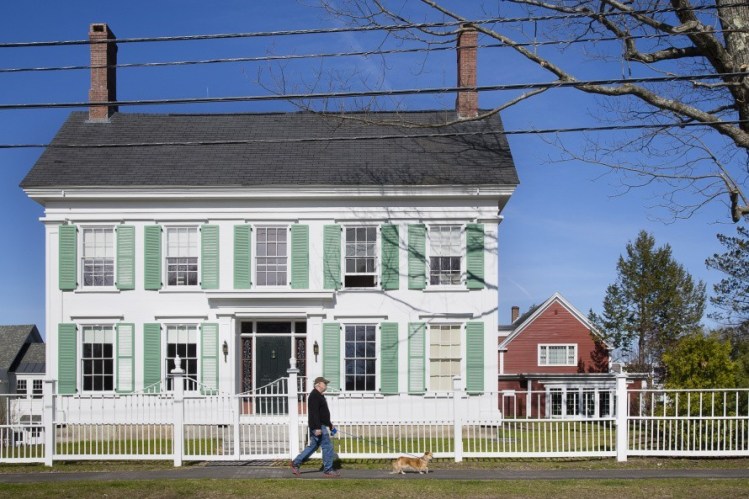BRUNSWICK — What’s now a closet in the house at 63 Federal St. was likely where Harriet Beecher Stowe let an escaped slave stay for a night in 1850, and a parlor room in the front of the home was probably one of the places she sat down to write “Uncle Tom’s Cabin” a year later.
Because of renovations done to the house soon after Stowe and her family left, little is known about what it looked like when they lived there. But research done by a Bowdoin College senior has helped restore the house to that time period and earn the site a place in the National Underground Railroad Network to Freedom.

Bowdoin College senior Katie Randall, who researched the Harriet Beecher Stowe House and helped get it listed on the Underground Railroad Network of Freedom, stands in “Harriet’s Writing Room,” a new exhibit that will open to the public next month.
That distinction was awarded last week to the college, which has owned the house since 2001. Next month, the former parlor room will open to the public as “Harriet’s Writing Room.”
“There’s a pretty good chance,” Bowdoin student Katie Randall said about whether Stowe would have penned any of her prose in that very room – now adorned with a photograph of the influential author and a map of the town, including a tiny outline of the house, from around the time she lived there.
As a housewife, Stowe likely wrote wherever she spent time, including the kitchen and dining room.
“It was really all over the house,” Randall said.
The house later became an inn that closed in 1998 and then was left untouched. It was designated a National Historic Landmark in 1962.
A professor who knew of Randall’s interest in historic preservation solicited her help in researching the house’s history to advocate for its restoration and succeeded in convincing the college to renovate it last year.
As an independent study in the fall, Randall put together an application to the National Park Service showing the house’s significance as part of the Underground Railroad. She focused on time spent there by freedom-seeker John Andrew Jackson, whose stories brought slavery to life for Stowe and helped motivate her to write the book that’s credited with inciting the start of the Civil War.
Jackson went on to lecture against slavery and become an author himself, writing an autobiography called, “The Experience of a Slave in South Carolina.”
Considering both ties to abolitionism, Randall said, “it was basically a shoe-in” to be added to the Network of Freedom, Park Service program.
But it’s still exciting for it to finally happen, she said, especially at the same time the house is opening to the public – and all right before her graduation. A Massachusetts native, Randall will head to the University of Pennsylvania in the fall to pursue dual master’s degrees in historic preservation and city planning.
A reading table with copies of “Uncle Tom’s Cabin” had yet to arrive Wednesday in the exhibit room, which, aside from its layout, probably doesn’t look much like it did when Stowe lived there from 1850 to 1852, while her husband taught at Bowdoin, his alma mater.

Now a Bowdoin College office, this room in the Harriet Beecher Stowe House on Federal Street in Brunswick is believed to be where a slave stayed while Stowe was living in the home. John Andrew Jackson’s stories about slavery likely inspired Stowe’s book “Uncle Tom’s Cabin.”
The renovations, including the removal of a dormer and a deteriorating structure that connected the house to a barn in back, are meant to replicate how the house looked after the 1855 renovations. The shutters were painted a distinct mint green, a popular color for the period but not necessarily what was on them.
Because of the lack of historic material left, there was little motivation to turn it into a museum.
Most of the house is filled with faculty offices, which Randall believes represents how it was used by Stowe and keeps the story going.
“The house is so much more than those two years,” she said, referring to the time Stowe lived there.
Years before her, poet Henry Wadsworth Longfellow had lived in the house while a student at the college.
“It’s a beautiful house,” Randall said. “If people only know it for that, I’ll be happy.”
Send questions/comments to the editors.




Comments are no longer available on this story